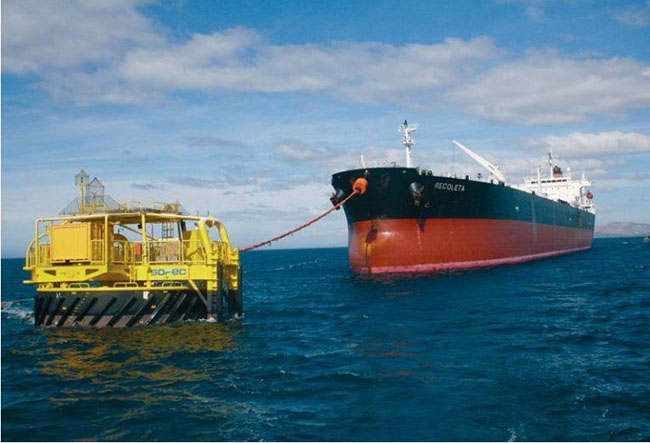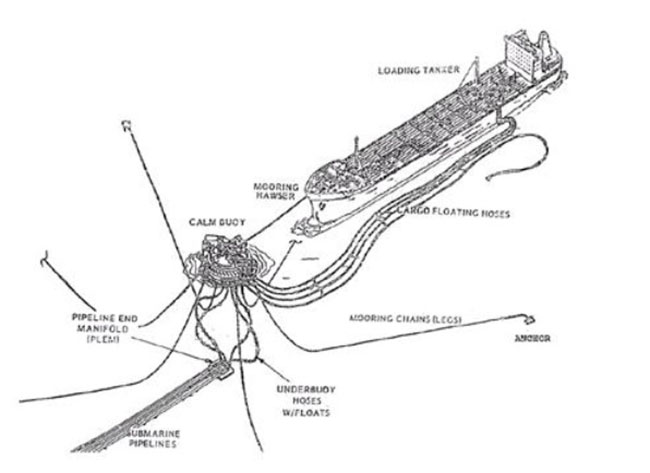Single point mooring (SPM) is a floating buoy/jetty anchored offshore to allow handling of liquid cargo such as petroleum products for tanker ships. SPM is mainly used in areas where a dedicated facility for loading or unloading liquid cargo is not available. Located at a distance of several kilometers from the shore-facility and connected using sub-sea and sub-oil pipelines, these single point mooring (SPM) facilities can even handle vessels of massive capacity such as VLCC.
Single point mooring (SPM) serves as a link between the shore-facilities and the tankers for loading or off-loading liquid and gas cargo. Some of the major benefits of using SPM are:
Ability to handle extra large vessels
Doesn’t require ships to come to the port and thus save fuel and time
Ships with high drafts can be moored easily
Large quality of cargo can be easily handled

The offshore-anchored loading buoy is divided into different parts having dedicated functionality.Mooring and anchoring system, buoy body and product transfer system are the main parts of the SPM.
The SPM is moored to the seabed using mooring arrangement which includes anchors, anchor chains, chain stoppers etc. The mooring arrangement is such that it permits the buoy to move freely within defined limits, considering wind, waves, current, and tanker ship conditions. The buoy is anchored to the seabed using anchor chains (legs) which are attached to the anchor point (gravity based or piled) on the seabed. Chain stoppers are used to connect the chains to the buoy.

The part of the Single Point Mooring System (buoy body) which is floating above the water has a rotating part which connects to the tanker. The rotating part allows the tanker to get stable at its desired position around the buoy. The tanker is usually moored to the buoy by means of a hawser arrangement, which consists of nylon or polyester ropes shacked to an integrated hook on the buoy deck. Chafe chains are connected at the tanker end of the hawser to prevent damage from tanker fairlead. The mooring systems used for such offshore operations follow the standards put forth by Oil Companies International Marine Forum (OCIMF).
The product transfer system is located at the heart of the mooring buoy. The system transfers products to the tanker from the Pipeline End and Manifold (PLEM) (geostatic location) located on the seabed. Flexible hoses known as risers connect the subsea pipelines to the buoy’s product transfer system. The buoy is connected to the tankers using floating hose strings, which are provided with breakaway couplings ( A special type of coupling with a break point which will break at a predetermined break load, activating internals valves which will automatically close at both ends and prevent further release of products.) to prevent oil spills.
Single Point Mooring Systems use a swivel system which connects the Pipeline End and Manifold (PLEM) to the buoy. The product swivel system provides flexibility of movement to the tankers during transfer of products. This movable pipe-connection system prevents premature hose failure due to traction or bending stresses.
General overview on how single point mooring (SPM) system works.The tanker ship is moored to the buoy for loading or unloading of cargo.A boat landing space on the the buoy deck provides access to the buoy for setting up the connections and securing the ship.
Fenders are used to protect the buoy from unexpected movement of the ship due to bad weather.Lifting and handling equipment on the buoy allows handling of hoses connections and safety tools.Once the connections are made, valves are operated from the electrical substation.Necessary alarm systems and navigational aids are provided as safety precautions.Liquid cargo is transfered from geostatic location (Pipeline End and Manifold (PLEM)) to the tanker using product transfer system of the single point mooring system.
-----The news is quoted from Marine Insight By Raunek (https://www.marineinsight.com/)
Note: If you found anything violating your copyright, please contact us, we would remove them as soon as possible.





